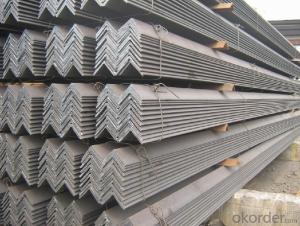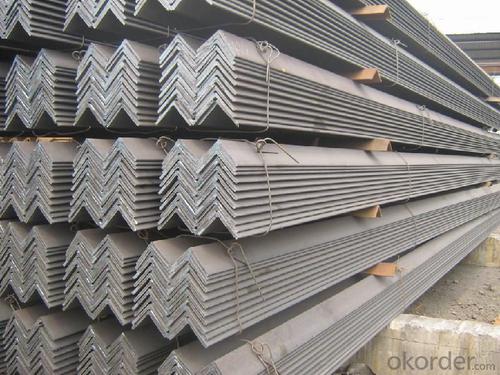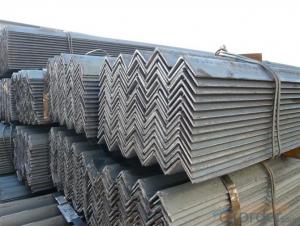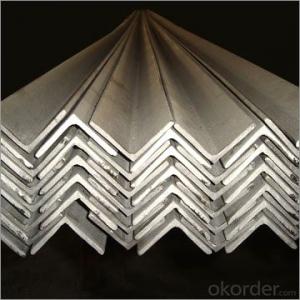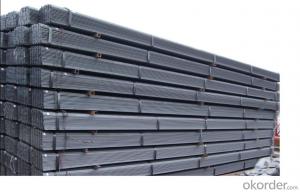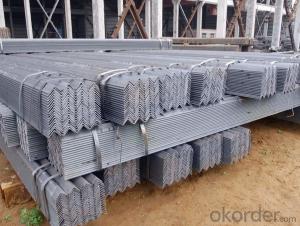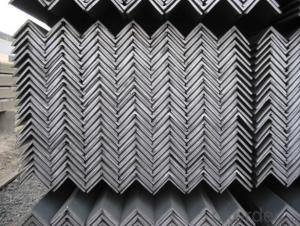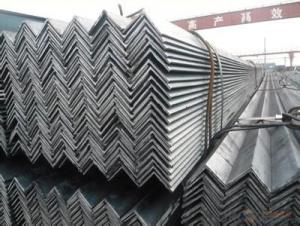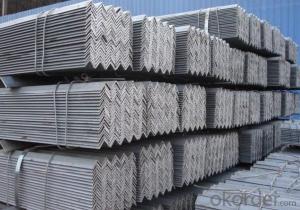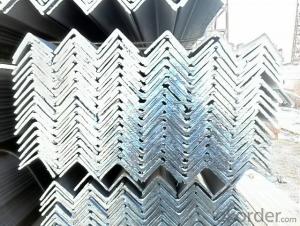Angle steel hot rolled high qulity ASTM A36 GB Q235B
- Loading Port:
- Tianjin
- Payment Terms:
- TT OR LC
- Min Order Qty:
- 50 m.t.
- Supply Capability:
- 200000 m.t./month
OKorder Service Pledge
OKorder Financial Service
You Might Also Like
Angle Steel Details:
| Minimum Order Quantity: | 25mtons | Unit: | m.t. | Loading Port: | China Main Port |
| Supply Ability: | 80000-100000MTS/YEAR | Payment Terms: | TT or LC |
Product Description:
Specifications of Angle Steel
1. Invoicing on theoretical weight or actual weight as customer request
2. Length: 6m, 9m, 12m as following table
3. Sizes
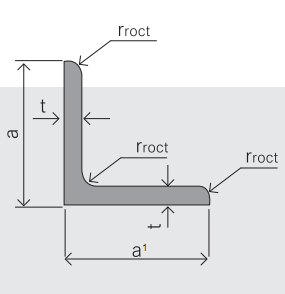
Sizes: 25mm-250mm | ||
a*t | ||
25*2.5-4.0 | 70*6.0-9.0 | 130*9.0-15 |
30*2.5-6.6 | 75*6.0-9.0 | 140*10-14 |
36*3.0-5.0 | 80*5.0-10 | 150*10-20 |
38*2.3-6.0 | 90*7.0-10 | 160*10-16 |
40*3.0-5.0 | 100*6.0-12 | 175*12-15 |
45*4.0-6.0 | 110*8.0-10 | 180*12-18 |
50*4.0-6.0 | 120*6.0-15 | 200*14-25 |
60*4.0-8.0 | 125*8.0-14 | 250*25 |
5. Payment terms:
1).100% irrevocable L/C at sight.
2).30% T/T prepaid and the balance against the copy of B/L.
3).30% T/T prepaid and the balance against L/C
6.Material details:
Alloy No | Grade | Element (%) | |||||
C | Mn | S | P | Si | |||
|
|
|
|
|
|
| |
Q235 | B | 0.12—0.20 | 0.3—0.7 | ≤0.045 | ≤0.045 | ≤0.3 | |
|
|
|
|
|
|
| |
Alloy No | Grade | Yielding strength point( Mpa) | |||||
Thickness (mm) | |||||||
≤16 | >16--40 | >40--60 | >60--100 | ||||
≥ | |||||||
|
|
|
|
|
| ||
Q235 | B | 235 | 225 | 215 | 205 | ||
Alloy No | Grade | Tensile strength (Mpa) | Elongation after fracture (%) | ||||
Thickness (mm) | |||||||
| ≤16 | >16--40 | >40--60 | >60--100 | |||
≥ | |||||||
|
|
|
|
|
|
| |
Q235 | B | 375--500 | 26 | 25 | 24 | 23 | |
Usage & Applications of Angle Steel
According to the needs of different structures, Angle can compose to different force support component, and also can be the connections between components. It is widely used in various building structures and engineering structures such as roof beams, bridges, transmission towers, hoisting machinery and transport machinery, ships, industrial furnaces, reaction tower, container frame and warehouse etc.
Packaging & Delivery of Angle Steel
1. Packing: it is nude packed in bundles by steel wire rod
2. Bundle weight: not more than 3.5MT for bulk vessel; less than 3 MT for container load
3. Marks:
Color marking: There will be color marking on both end of the bundle for the cargo delivered by bulk vessel. That makes it easily to distinguish at the destination port.
Tag mark: there will be tag mark tied up on the bundles. The information usually including supplier logo and name, product name, made in China, shipping marks and other information request by the customer.
If loading by container the marking is not needed, but we will prepare it as customer request.
Production flow of Angle Steel
Material prepare (billet) —heat up—rough rolling—precision rolling—cooling—packing—storage and transportation
- Q: How do you design connections for steel angles?
- When designing connections for steel angles, several factors need to be considered to ensure structural integrity and safety. Here are the key steps in designing connections for steel angles: 1. Determine the load and forces: Understand the loads the connection will be subjected to, such as tension, compression, or shear forces. Calculate the magnitude and direction of these forces to accurately assess the connection's requirements. 2. Select the type of connection: Determine the appropriate connection type based on the forces involved, structural design, and aesthetic requirements. Common connection types for steel angles include bolted, welded, or a combination of both. 3. Size the angles: Determine the appropriate size of the steel angles based on the loads and forces. Consider the angle's cross-sectional shape, material strength, and desired safety factors to ensure it can withstand the applied loads. 4. Check for interaction effects: Assess any interaction effects between the connection and the structural members. Account for any changes in the behavior of the angles due to the connection, such as added stiffness or reduction in capacity. 5. Design the connection details: Once the connection type and angle size are determined, design the connection details. Consider factors like the number and size of bolts, welding specifications, edge distances, and spacing requirements. 6. Check for failure modes: Analyze the connection design for potential failure modes, such as bearing, tearing, or shearing. Ensure that the connection has adequate strength and ductility to resist these failure modes. 7. Perform calculations and analysis: Utilize appropriate engineering principles and standards to perform calculations and analysis on the connection design. Check for factors like static equilibrium, stress distribution, and load transfer to confirm the connection's adequacy. 8. Incorporate design codes and standards: Adhere to relevant design codes and standards, such as the American Institute of Steel Construction (AISC) Manual, to ensure compliance with industry best practices and safety requirements. 9. Consider constructability and ease of fabrication: While designing connections, consider the constructability and ease of fabrication. Aim for simplicity in connection details to facilitate efficient manufacturing and construction processes. 10. Review and revise: Finally, review the connection design and seek input from structural engineers or other experts. Revise the design as necessary based on their recommendations to optimize the connection's performance and efficiency. By following these steps, engineers can design connections for steel angles that effectively transfer forces, ensure structural stability, and meet safety requirements.
- Q: Can steel angles be used in cold climates?
- Yes, steel angles can be used in cold climates. Steel is known for its strength and durability, making it suitable for various construction applications, including in cold climates. Steel angles are commonly used in structural framing, supports, and reinforcements, offering stability and load-bearing capabilities. Additionally, steel has a high resistance to extreme temperatures, including cold weather conditions, making it a reliable choice for construction projects in cold climates. However, it is important to consider the specific requirements and regulations for cold climate construction to ensure proper insulation and protection against freezing temperatures.
- Q: How do you calculate the effective length of a steel angle?
- When calculating the effective length of a steel angle, there are two main factors to consider: the actual length of the angle and the stability of its supported members. To begin, you must determine the actual length of the steel angle. This can be done by physically measuring it or referring to the manufacturer's specifications. It is crucial to have the precise length value for the calculation. Next, evaluate the stability of the angle's supported members. The effective length of the angle is influenced by the specific conditions in which it is being used and supported. There are three primary support conditions to take into account: pinned-pinned, fixed-fixed, and fixed-pinned. In the case of a pinned-pinned support condition, the effective length is equal to the actual length of the angle. This condition assumes that both ends of the angle can freely rotate, allowing the full length to effectively resist applied loads. For a fixed-fixed support condition, the effective length is typically considered as 0.7 times the actual length. This condition assumes that both ends of the angle are rigidly connected, resulting in a reduced effective length due to the increased stiffness of the entire system. In a fixed-pinned support condition, the effective length is usually 0.85 times the actual length. In this scenario, one end of the angle is fixed while the other end can rotate freely, leading to a decreased effective length compared to the actual length. Accurately determining the support conditions of the steel angle is essential for correctly calculating its effective length. In addition, a comprehensive analysis of the angle's behavior should consider other factors such as its material properties, cross-section, and loading conditions.
- Q: Can steel angles be used for electrical conduits?
- No, steel angles cannot be used as electrical conduits. Electrical conduits are typically made of non-metallic materials such as PVC or metal materials such as galvanized steel or aluminum. Steel angles are structural components used for support and reinforcement in construction projects, but they are not designed or suitable for use as electrical conduits. Electrical conduits have specific requirements for insulation, protection, and grounding, which steel angles do not provide. It is important to use proper electrical conduits that meet the necessary safety standards to ensure the integrity and efficiency of electrical installations.
- Q: How do you prevent and address corrosion in steel angles?
- To prevent and address corrosion in steel angles, several measures can be taken. Firstly, applying a protective coating such as paint or galvanization can create a barrier between the steel and corrosive elements. Regular maintenance and inspection are also crucial to identify and address any signs of corrosion early on. Additionally, keeping the steel angles clean and dry, and avoiding contact with corrosive substances, can significantly reduce the risk of corrosion. Implementing proper drainage and ventilation systems in areas where steel angles are installed can also help prevent moisture buildup, which is a common cause of corrosion.
- Q: Are steel angles suitable for historical restoration projects?
- Yes, steel angles can be suitable for historical restoration projects. They offer excellent strength and durability, which is useful for structural support and reinforcement. Additionally, steel angles can be easily fabricated to match the original design and can be finished to closely resemble the aesthetic of historical materials. However, careful consideration should be given to the specific project requirements and the preservation of historical integrity.
- Q: How are steel angles protected during transportation and storage?
- Steel angles are protected during transportation and storage by applying a layer of protective coating, such as oil or paint, to prevent rust and corrosion. Additionally, they are often bundled and secured with straps or bands to ensure they remain stable and do not get damaged during handling and movement.
- Q: What is the cost of steel angles compared to other structural materials?
- The cost of steel angles compared to other structural materials can vary depending on factors such as the specific type of material, market conditions, and quantity needed. However, generally speaking, steel angles tend to be a cost-effective choice for structural applications due to their durability, strength, and versatility.
- Q: Can steel angles be used for bracing?
- Yes, steel angles can be used for bracing. Steel angles are commonly used as structural supports to provide strength and stability in various applications, including bracing in construction and engineering projects. Their L-shaped design allows them to distribute forces and resist bending, making them suitable for bracing purposes.
- Q: How do you calculate the slenderness ratio of a steel angle?
- To calculate the slenderness ratio of a steel angle, you need to determine the length and the moment of inertia of the angle section. The slenderness ratio is a measure of how slender or slender a member is, and it helps in determining its stability and ability to resist buckling. First, measure the length of the steel angle, which is the distance between its two ends. This length should be measured in the same unit as the dimensions of the angle section. Next, calculate the moment of inertia of the steel angle section. The moment of inertia is a measure of the section's resistance to bending and is typically denoted by the symbol "I". It depends on the dimensions of the angle section and can be obtained from reference tables or calculated using mathematical formulas. Once you have the length and moment of inertia of the steel angle, you can calculate the slenderness ratio using the formula: Slenderness ratio = (Length of angle) / (√(Moment of inertia)) Make sure the length and moment of inertia are expressed in the same unit before performing the calculation. The resulting slenderness ratio will be a dimensionless value. It is important to note that the slenderness ratio is used to determine the appropriate design criteria and allowable loads for the steel angle. Different design codes or standards may have specific limits or guidelines for the maximum slenderness ratio that can be used safely in different applications. Therefore, it is crucial to consult the relevant design codes or seek professional engineering advice to ensure the correct and safe use of the steel angle.
Send your message to us
Angle steel hot rolled high qulity ASTM A36 GB Q235B
- Loading Port:
- Tianjin
- Payment Terms:
- TT OR LC
- Min Order Qty:
- 50 m.t.
- Supply Capability:
- 200000 m.t./month
OKorder Service Pledge
OKorder Financial Service
Similar products
Hot products
Hot Searches
Related keywords
